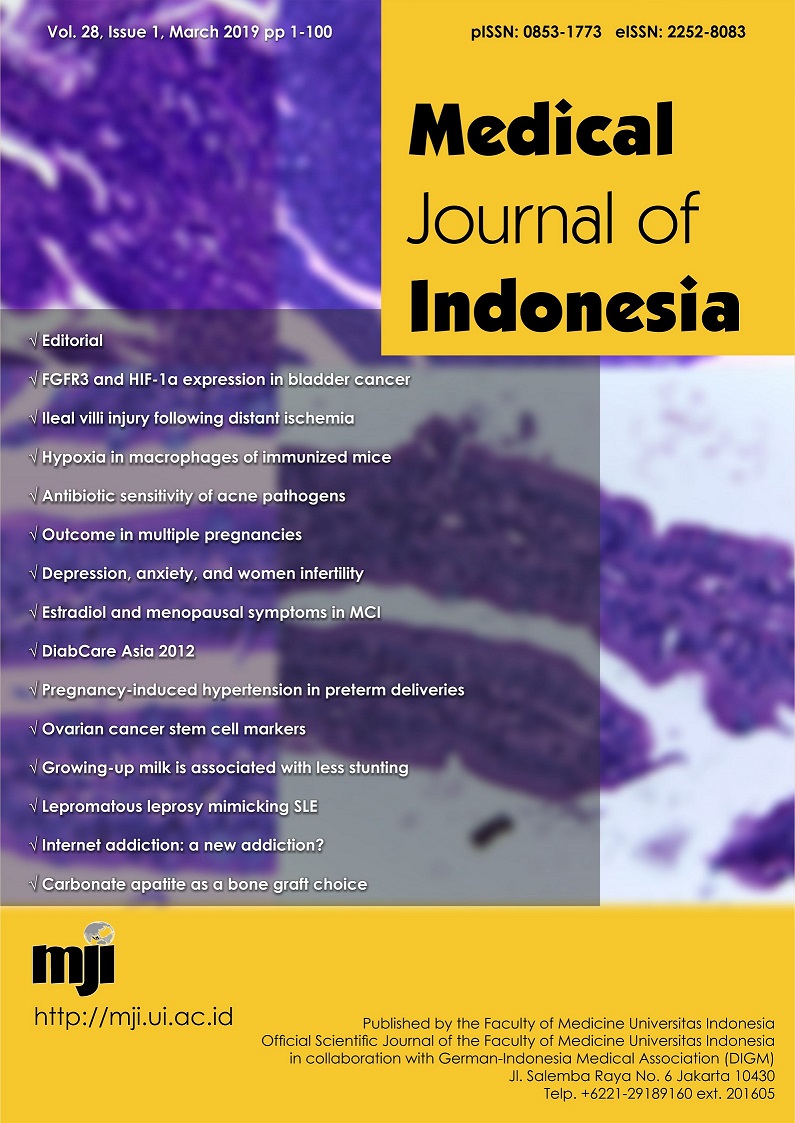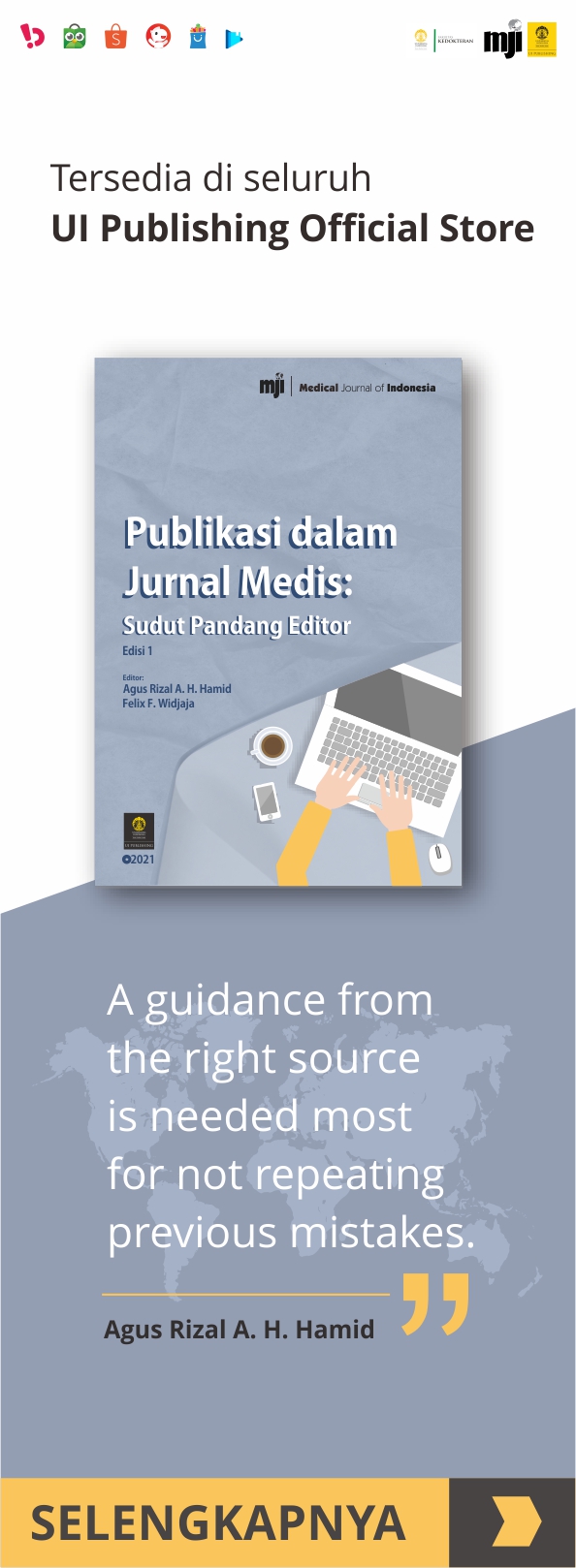Efforts to overcome hypoxia condition in Balb/c mouse macrophages after intraperitoneal SRBC immunization
DOI:
https://doi.org/10.13181/mji.v28i1.1961Keywords:
cytoglobin, hypoxia, macrophage, HIF-1α, HIF-2α, PGC-1αAbstract
BACKGROUND Activated macrophages require increased oxygen to destroy foreign bodies, leading to an increase in the levels of reactive oxygen species (ROS). Therefore, macrophages would experience hypoxic and oxidative stress conditions at the same time. Thus, this study was aimed to evaluate the mechanism of the activated macrophages to overcoming this dual condition.
METHODS The activated macrophages were harvested from the intraperitoneal cavities of 18 BALB/c mice immunized with 2% sheep red blood cells (SRBCs). The macrophage suspension was divided into four groups: control, 24, 48, and 72 hours after-immunization groups. The expressions of hypoxia-inducible factor (HIF)-1α, HIF-2α, and cytoglobin (Cygb), as markers for hypoxic condition, were measured by quantitative reverse transcription polymerase chain reaction (qRT-PCR) and enzyme-linked immunosorbent assay (ELISA), whereas peroxisome proliferator-activated receptor gamma coactivator (PGC-1α) protein as a marker for mitochondrial biogenesis and aerobic metabolism was measured with ELISA. The analysis of oxidative stress was conducted with the water-soluble tetrazolium salt test.
RESULTS The HIF-1α mRNA expression was the highest at 24 hours, whereas the HIF-2α mRNA showed no increased expression during the observation. The Cygb mRNA decreased after 24 hours. The highest expressions of HIF-1α and HIF-2α proteins were detected at 72 hours, whereas the Cygb protein expression increased since 24 hours. The PGC-1α protein expression increased at 72 hours. The WST test showed the highest ROS level at 24 hours.
Downloads
References
Wang C, Yu X, Cao Q, Wang Y, Zheng G, Tan TK, et al. Characterization of murine macrophages from bone marrow, spleen and peritoneum. BMC Immunol. 2013;14:6. https://doi.org/10.1186/1471-2172-14-6
Weinberg JB. Mononuclear phagocytes. In (Lee GR, Foerster J, Luckens J, Paravekas F, Greer JP, Rodgers GM, eds). Wintroub’s Clinical Haematology. Philadelphia: Lippincot Williams and Wilkins. 1998. p. 377–414.
Slauch JM. How does the oxidative burst of macrophages kill bacteria? still an open question. Mol Microbiol. 2011;80(3):580–3. https://doi.org/10.1111/j.1365-2958.2011.07612.x
Ies KE, Forman HJ. Macrophage signaling and respiratory burst. Immunol Res. 2002;26(1–3):95–105. https://doi.org/10.1385/IR:26:1-3:095
de Duve C. The lysosome turns fifty. Nat Cell Biol. 2005;7(9):847–9. https://doi.org/10.1038/ncb0905-847
Wang GL, Semenza GL. General involvement of hypoxia-inducible factor 1 in transcriptional response to hypoxia. Proc Natl Acad Sci U S A. 1993;90(9):4304–8. https://doi.org/10.1073/pnas.90.9.4304
Semenza GL. Hypoxia-inducible factors in physiology and medicine. Cell. 2012;148(3):399–408. https://doi.org/10.1016/j.cell.2012.01.021
Zhao C, Du W. Dynamic features of carboxy cytoglobin distal mutants investigated by molecular dynamics simulations. J Biol Inorg Chem. 2016;21(2):251–61. https://doi.org/10.1007/s00775-016-1334-2
Jusman SW, Halim A, Wanandi SI, Sadikin M. Expression of hypoxia-inducible factor-1a (HIF-1a) related to oxidative stress in liver or rats-induced by systemic chronic normobaric hypoxia. Acta Med Indones. 2010;42(1):17–23.
Liu H, Mao P, Wang J, Wang T, Xie CH. Allicin protects PC12 cells against 6-OHDA-induced oxidative stress and mitochondrial dysfunction via regulating mitochondrial dynamics. Cell Physiol Biochem. 2015;36(3):966–79. https://doi.org/10.1159/000430271
Ray A, Dittel BN. Isolation of mouse peritoneal cavity cells. J Vis Exp. 2010;(35):1488. https://doi.org/10.3791/1488
Layoun A, Samba M, Santos M. Isolation of murine peritoneal macrophages to carry out gene expression analysis upon Toll-like receptors stimulation. J Vis Exp. 2015;(98):e52749. https://doi.org/10.3791/52749
Von V. Expressions-und funktionsanalysen von neuroglobin und cytoglobin. Dissertation. Mainz: Johanes Gutenberg-Universitat; 2007.
Babior BM. The respiratory burst of phagocytes. J Clin Invest. 1984;73(5):599–601. https://doi.org/10.1172/JCI111249
Cross AR, Segal AW. The NADPH oxidase of professional phagocytes–prototype of the NOX electron transport chain systems. Biochim Biophys Acta. 2004;1657(1):1–22. https://doi.org/10.1016/j.bbabio.2004.03.008
Halliwell B, Gutteridge JM. Free radicals in biology and medicine. 3rd Ed. London: Oxford University Press; 1999. In (Blanksby S, Ellison GB, Bierbaum Vm, Kato S, eds). Superoxide does react with peroxides: direct observation of the Haber-Weiss reaction in the gas phase. Angew Chem Int Ed Engl. 2007;46(26):4948–50. https://doi.org/10.1002/anie.200700219
McCord JM, Fridovich I. Superoxide dismutase. An enzymic function for erythrocuprein (hemocuprein). J Biol Chem. 1969;244(22):6049–55.
Jusman SW, Iswanti FC, Suyatna FD, Ferdinal F, Wanandi SI, Sadikin M. Cytoglobin expression in oxidative stressed liver during systemic chronic normobaric hypoxia and relation with HIF-1a. Med J Indones. 2014;23(3):133–8. https://doi.org/10.13181/mji.v23i3.1025
Cash TP, Pan Y, Simon MC. Reactive oxygen species and cellular oxygen sensing. Free Radic Biol Med. 2007;43(9):1219–25. https://doi.org/10.1016/j.freeradbiomed.2007.07.001
Krock BL, Skuli N, Simon MC. Hypoxia-induced angiogenesis: good and evil. Genes Cancer. 2011;2(12):1117–33. https://doi.org/10.1177/1947601911423654
Aranggo Duque A, Descoteaux A. Macrophages cytokines: involvement in immunity and infectious diseases. Front Immunol. 2014;5:491. https://doi.org/10.3389/fimmu.2014.00491
Abbas AK, Lichtman AH, Pillai S. Cellular and molecular immunology. 6th Edition. Philadelphia: Elsevier Publisher; 2007. p. 544
Yang D, Elner SG, Bian ZM, Till GO, Petty HR, Elner VM. Pro-inflammatory cytokines increase reactive oxygen species through mitochondria and NADPH oxidase in cultured RPE cells. Exp Eye Res. 2007;85(4):462–72. https://doi.org/10.1016/j.exer.2007.06.013
D’Errico I, Salvatore L, Murzilli S, Lo Sasso G, Latorre D, Martelli N, et al. Peroxisome proliferator-activated receptor-g coactivator 1-a (PGC-1a) is a metabolic regulator of intestinal epithelial cell fate. Proc Natl Acad Sci U S A. 2011;108(16):6603–8. https://doi.org/10.1073/pnas.1016354108
Berridge MV, Herst PM, Tan AS. Tetrazolium dyes as tools in cell biology: new insights into their cellular reduction. Biotechnol Annu Rev. 2005;11:127–52. https://doi.org/10.1016/S1387-2656(05)11004-7
Buzgariu W, Zarnescu O, Caloianu M, Coroiu V, Titescu GH, Stefanescu I. Ultrastructural and functional changes in mitochondria induced by heavy water in vitro. Rev Roum Biol. 2003;48(1–2);103–14.
Published
How to Cite
Issue
Section
License
Authors who publish with Medical Journal of Indonesia agree to the following terms:
- Authors retain copyright and grant Medical Journal of Indonesia right of first publication with the work simultaneously licensed under a Creative Commons Attribution-NonCommercial License that allows others to remix, adapt, build upon the work non-commercially with an acknowledgment of the work’s authorship and initial publication in Medical Journal of Indonesia.
- Authors are permitted to copy and redistribute the journal's published version of the work non-commercially (e.g., post it to an institutional repository or publish it in a book), with an acknowledgment of its initial publication in Medical Journal of Indonesia.






































